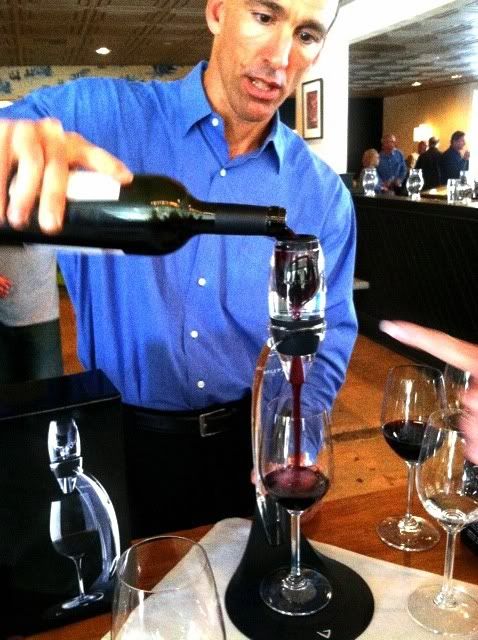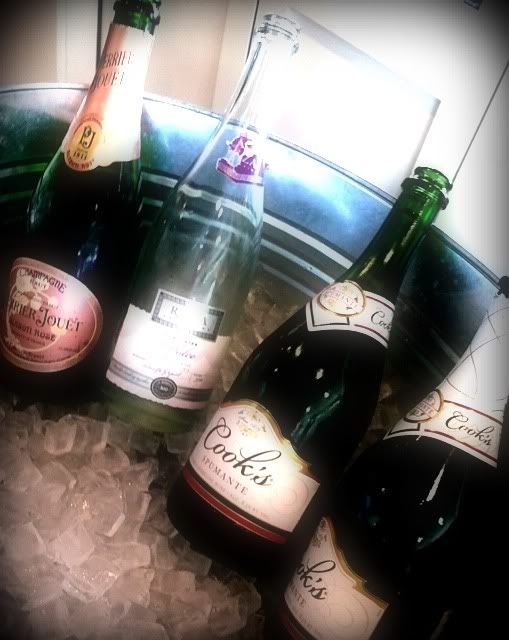Sometimes I wonder how tough the competition was when I taste a wine which boasts that it won a medal. Almost all the 26 double gold winners from the 2011 San Francisco International Wine Competition I tasted at this Tasting Panel event were credibly good wines, but a few left me scratching my head. That's not too easy to do with a glass, a sheet of paper and a pen in my hands, which is how I spent an hour on September 22, 2011 at Waterloo & City in Culver City, California.
The three boxed wines - a Sauvignon Blanc, a Pinot Grigio and a Riesling - were drinkable, but certainly not exceptional, to my palate. Is there a category for boxed wine? Were these the only three in that category?
There were a few that did get my attention, as they got the attention of the judges at the competition. Here are the double gold winners which I had no trouble accepting as just that:
Raza 2011 Torrentes Sweet Sparkling Wine (Famatina Valley, Argentina) - This demi-sec is prize-worthy. A fruity, sweet nose invites a taste and the palate is rewarded with a lovely, sweet peach/pear/melon combo. All this, and bubbles, too.
Saint Clair Family Estate 2010 Sauvignon Blanc (Marlborough, New Zealand) - The grassiness takes a back seat to some beautiful lime notes on the nose, while lime meets wet rocks on the palate. Outstanding acidity, with a gorgeous finish reminiscent of limeade.
Türk 2009 Grüner Veltliner (Kremstal, Austria) - Minerals on the nose try to block the apple and citrus aromas from getting through, but without success. A very nice acidity pairs perfectly with the mineral-laden palate.
Fritz Winery 2009 Chardonnay (Russian River Valley) - Oaky custard on the nose and tasting of buttery fruit, this is not a Chardonnay for unoaked fans. There's a very nice burnt caramel apple finish, too.
Jenner 2009 Pinot Noir (Sonoma Coast) - The nose of candied strawberry is replicated on the beautiful, fruit forward palate. Great acidity.
Martin Ranch Winery 2009 Malbec (Dos Ninas Vineyards, Santa Clara Valley) - Smokey cherry and blueberry on the nose, with complex dusty fruit flavors.
Cakebread Cellars 2008 Merlot (Napa Valley) - A floral and fruity nose with oak influenced red fruit flavors.
Bethany Wines 2005 Shiraz GR10 Reserve (Barossa, Australia) - Aromas of dark fruit and a hint of meat; on the palate, that meatiness gives the fruit a run for its money.
Hope Family Wines Troublemaker Blend 2 (Paso Robles) - This Rhone blend has an amazing nose full of dark fruit. The palate is dark, too, with spicy notes.
Colcanyon Estates Wines 2008 Cabernet Sauvignon (Los Angeles County) - This Malibu wine - what, you didn't know they grow grapes in the 'Bu? - shows very dark fruit aromas and tons of meatiness. It seems almost odd that it's so lovely on the palate. During the sip, I had a hard time believing it was a Cab, but on the finish there was no mistaking it.
Hughes Wellman 2007 Cabernet Sauvignon (Napa Valley) - This one is all Cabernet, from top to bottom; a really nice quaff with fine tannins.
 Vinturi was at the event, showing their line of wine aerators. Since I had not tried the Vinturi yet, I lined up for the side-by-side comparison. I must admit that although I had heard and read that the units worked quite well, I was still skeptical.
Vinturi was at the event, showing their line of wine aerators. Since I had not tried the Vinturi yet, I lined up for the side-by-side comparison. I must admit that although I had heard and read that the units worked quite well, I was still skeptical.
Vinturi representative John Moraytis poured a bit of Feather Columbia Valley Cabernet Sauvignon from an open bottle and another sample of the same wine which he ran through the Vinturi aerator while I watched. I can vouch that there was nothing up his sleeve - the sample he poured into the Vinturi was out of the same bottle from which the unaerated sample came.
The difference was noticeable. The aerated sample was rounder and softer than the one straight from the bottle. The tannic structure wasn't diminished in the least, the wine was simply a little easier to drink. It even showed a little more complexity, with some different notes coming forward on both the nose and palate.
I should mention, in the interest of full disclosure, that Vinturi gave me - and all the attendees at this event - a travel size aerator to take home. The travel size and the regular size both work the same way - you pour the wine into a hole in the top of the unit.
The hole on the travel size is a bot smaller than on the regular version, so a steady hand is necessary. There is a stand for the regular version which allows you to put the wine glass underneath the unit to catch the aerated wine. All three elements - regular, travel and stand - cost about $40 each. There's a package available with both the stand and the regular size Vinturi which costs $70.
Follow Randy Fuller on Twitter
The three boxed wines - a Sauvignon Blanc, a Pinot Grigio and a Riesling - were drinkable, but certainly not exceptional, to my palate. Is there a category for boxed wine? Were these the only three in that category?
There were a few that did get my attention, as they got the attention of the judges at the competition. Here are the double gold winners which I had no trouble accepting as just that:
Raza 2011 Torrentes Sweet Sparkling Wine (Famatina Valley, Argentina) - This demi-sec is prize-worthy. A fruity, sweet nose invites a taste and the palate is rewarded with a lovely, sweet peach/pear/melon combo. All this, and bubbles, too.
Saint Clair Family Estate 2010 Sauvignon Blanc (Marlborough, New Zealand) - The grassiness takes a back seat to some beautiful lime notes on the nose, while lime meets wet rocks on the palate. Outstanding acidity, with a gorgeous finish reminiscent of limeade.
Türk 2009 Grüner Veltliner (Kremstal, Austria) - Minerals on the nose try to block the apple and citrus aromas from getting through, but without success. A very nice acidity pairs perfectly with the mineral-laden palate.
Fritz Winery 2009 Chardonnay (Russian River Valley) - Oaky custard on the nose and tasting of buttery fruit, this is not a Chardonnay for unoaked fans. There's a very nice burnt caramel apple finish, too.
Jenner 2009 Pinot Noir (Sonoma Coast) - The nose of candied strawberry is replicated on the beautiful, fruit forward palate. Great acidity.
Martin Ranch Winery 2009 Malbec (Dos Ninas Vineyards, Santa Clara Valley) - Smokey cherry and blueberry on the nose, with complex dusty fruit flavors.
Cakebread Cellars 2008 Merlot (Napa Valley) - A floral and fruity nose with oak influenced red fruit flavors.
Bethany Wines 2005 Shiraz GR10 Reserve (Barossa, Australia) - Aromas of dark fruit and a hint of meat; on the palate, that meatiness gives the fruit a run for its money.
Hope Family Wines Troublemaker Blend 2 (Paso Robles) - This Rhone blend has an amazing nose full of dark fruit. The palate is dark, too, with spicy notes.
Colcanyon Estates Wines 2008 Cabernet Sauvignon (Los Angeles County) - This Malibu wine - what, you didn't know they grow grapes in the 'Bu? - shows very dark fruit aromas and tons of meatiness. It seems almost odd that it's so lovely on the palate. During the sip, I had a hard time believing it was a Cab, but on the finish there was no mistaking it.
Hughes Wellman 2007 Cabernet Sauvignon (Napa Valley) - This one is all Cabernet, from top to bottom; a really nice quaff with fine tannins.
 Vinturi was at the event, showing their line of wine aerators. Since I had not tried the Vinturi yet, I lined up for the side-by-side comparison. I must admit that although I had heard and read that the units worked quite well, I was still skeptical.
Vinturi was at the event, showing their line of wine aerators. Since I had not tried the Vinturi yet, I lined up for the side-by-side comparison. I must admit that although I had heard and read that the units worked quite well, I was still skeptical.Vinturi representative John Moraytis poured a bit of Feather Columbia Valley Cabernet Sauvignon from an open bottle and another sample of the same wine which he ran through the Vinturi aerator while I watched. I can vouch that there was nothing up his sleeve - the sample he poured into the Vinturi was out of the same bottle from which the unaerated sample came.
The difference was noticeable. The aerated sample was rounder and softer than the one straight from the bottle. The tannic structure wasn't diminished in the least, the wine was simply a little easier to drink. It even showed a little more complexity, with some different notes coming forward on both the nose and palate.
I should mention, in the interest of full disclosure, that Vinturi gave me - and all the attendees at this event - a travel size aerator to take home. The travel size and the regular size both work the same way - you pour the wine into a hole in the top of the unit.
The hole on the travel size is a bot smaller than on the regular version, so a steady hand is necessary. There is a stand for the regular version which allows you to put the wine glass underneath the unit to catch the aerated wine. All three elements - regular, travel and stand - cost about $40 each. There's a package available with both the stand and the regular size Vinturi which costs $70.
Follow Randy Fuller on Twitter

No comments:
Post a Comment